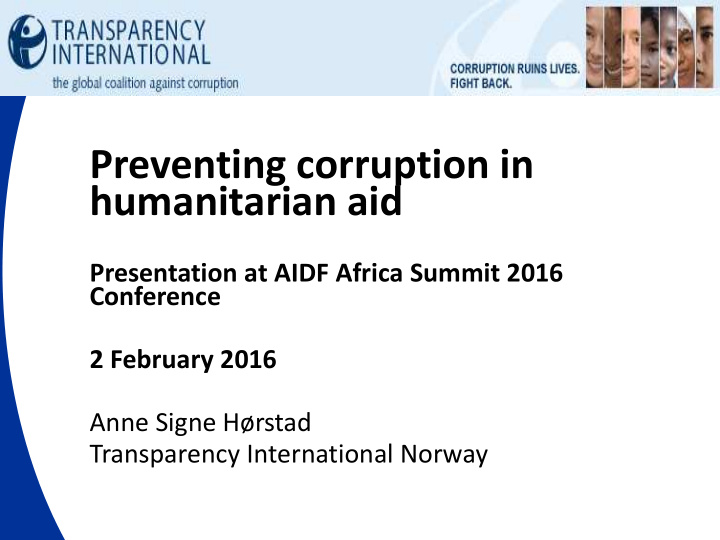



Preventing corruption in humanitarian aid Presentation at AIDF Africa Summit 2016 Conference 2 February 2016 Anne Signe Hørstad Transparency International Norway
Cpi 2015: The top RANK COUNTRY/TERRITORY SCORE 1 DENMARK 91 2 FINLAND 90 3 SWEDEN 89 4 NEW ZEALAND 88 5 NETHERLANDS 87 5 NORWAY 87 Denmark is in first place with score of 91, helped by strong access to information systems and rules governing the behaviour of those in public positions.
Cpi 2015: The bottom RANK COUNTRY/TERRITORY SCORE 161 IRAQ 16 161 LIBYA 16 163 ANGOLA 15 163 SOUTH SUDAN 15 165 SUDAN 12 166 AFGHANISTAN 11 167 KOREA (NORTH) 8 167 SOMALIA 8
Preventing corruption in humanitarian operations TI Handbook and Pocket Guide of Good Practices New edition 2014 IFRC, Catholic Relief Services, Lutheran World Federation, Care, Islamic Relief, World Vision, Save the Children 5
Background • Asian Tsunami crisis 2004 • Corruption Risk Map prepared by the Humanitarian Policy Group (ODI) in 2006 • Field research in partnership with seven leading humanitarian INGOs • Technical assistance from Feinstein International Center (Tufts Univ.) and ODI • Staff interviews in HQs and selected field operations of partner agencies; Research Report published July 2008 • Complemented by case studies on perceptions of aid recipients • Evidence base for TI Handbook on Good Practices and TI Pocket Guide published in 2010 6
What’s new in the updated TI Handbook? The current 2014 electronic version include an updated list of references and links as well as the following new tools: • 1) Remote Management • 2) Reputation Management • 3) Communication with Disaster-Affected Communities • 4) Information and Communication Technology. • 5) Construction and Reconstruction • 6) Cash as an Alternative The substantial increase in the last few years of materials on these topics led us to create entirely new tools.
Handbook organized in three sections: 1 Institution-wide anti-corruption policies and guidelines 2 Corruption risks in programme support functions 3 Corruption risks encountered during the operational programme cycle 8
Elements of the tools • Corruption risk • Watch out for (red flags) • Prevention measures • You’ll need (resources) • Be prepared for (challenges) • Reference material
Programme support functions • Supply Chain: Procurement (incl. substandard goods/services) Transport and storage (incl. payment for access to goods or beneficiaries) Asset management (vehicles, fuel) • Human Resources (incl. nepotism/cronyism, conflict of interest) • Finance (incl. special issues in cash programming)
Why focus on the supply chain? • Corruption can lead to major economic and reputational consequences for companies/organizations involved. Investments in preventive work will make companies less vulnerable for such consequences. Companies/organizations heavily involved in procurement activities have lately made strong efforts with A-C work within their organisation. • Companies/organizations are increasingly acknowledging the liability they may have for unethical activities in the supply chain
The procurement process (pre-qualification – invitation to bid – bid evaluation – award of contract – contract administration) Pre-qualification • Due diligence • Improvement plan Invitation to bid • A satisfactory code of conduct • A good anticorruption programme involving own employees and sub-suppliers Contract Administration • Supply Chain Management System (ethics and a-c) BEST TO HAVE THE ETHICS IN PLACE FROM BEGINNING
Key recommendations • Corruption mainly viewed as financial issue, not abuse of power. Importance of “non -financial corruption” . • Integrate corruption risk analysis into emergency preparedness and disaster risk reduction work. Build into staff training programs • Intensify on-site monitoring, essential to deterring and detecting corruption • Provide greater information transparency and accountability to beneficiaries, affected country governments and local CSOs • Break the taboo 13
Trade offs There is no magic formula! • Reputational risk vs. open discussion • Urgency/need for speed vs. safeguards • Pressure to spend vs. getting things right 14
Trade offs • Too many vs. too few controls • Transparency vs. staff and beneficiary security • Sanctions and information sharing vs. legal issues 15
E-learning
E-learning programme content 1. Disaster simulation 2. Dilemmas and choices 2. What is corruption? 3. Facilitation payments/bribes 4. Conflict of interest 5. Gifts 6. Exploitation 3. Identifying corruption signs and risks 2. Risks office scene 3. Risks outside office scene 4. Risks map scene 5. Prevention scene 4. Disaster simulation
Instructor Led Training (ILT)
Recommend
More recommend